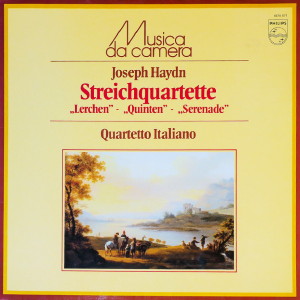 |
|
Philips
- 1 LP - 6570 577
|
|
QUARTETTO ITALIANO
- Paolo Borciani, Elisa Pegreffi, violino
- Piero Farulli,
viola
- Franco Rossi, violoncello |
|
|
|
|
|
Luogo e data
di registrazione |
|
Théâtre
Vevey, Vevey
(Svizzera) -
15-24 agosto 1965 |
|
|
Registrazione: live
/ studio |
|
studio |
|
|
Producer / Engineer |
|
Vittorio Negri |
Tony Buczynski |
|
|
Edizione LP |
|
Philips | 6570
577
| 1 LP |
|
|
Prima Edizione CD |
|
Vedi link alla prima
edizione in long playing.
|
|
|
Note |
|
La
collana
"Musica da
Camera" della
Philips
riedita negli
anni
'80
alcune
registrazioni
del Quartetto
Italiano. |
|
|
|
|
The
F major
Quartet, Op. 3
No. 5 is one
of a series
published in
1760.
Recently, some
diubt has been
cast on
authenticity
of these
works, because
they cannot be
clearly traced
hack to Haydn,
but the
construction,
melodic
invention, and
development
all point to
the younger
Haydn, who at
this date had
been for some
years musical
director to
Prince Esterházy,
and was
already a
celebrated
musician. The
work contains
a C major slow
movement,
which played
separately
under the
title
"Serenade"
spread Haydn a
fame far and
wide. It is an
Italian aria,
in which the
model first
violin plays
the melody
from start so
finish, while
the other
instruments
play a
pizzicato
accompaniment.
The compact
minuet is a
vigorous dance
movement, with
an attractive
trio, scured
without the
viola. The
remaining two
movements
which are
equally brief
show the
beginnings of
real thematic
working. In
the first
movement
exposition,
the themes are
clearly
differentiated.
The
development
keeps strictly
to the
previously
stated
thematic
material, and
head almost
unobtrusively
into the
slightly different
recapitulation.
The little
finale (scherzando)
is loosely
linked to the
first
movement, but
is essentially
of the gay
closing
movement type.
The
String Quartet
in D, Op. 64
No. 5, was
composed in
1790. It is
clearly a very
different work
from the F
major Quartet,
which still
bears traces
of the
divertimento.
The D major
Quartet is one
of the works
which Haydn
dedicated to
the Viennese
merchant,
Tost. Haydn's
art has now
reached a
technical and
musical
maturity,
which is
hereafter
maintained,
under the
different
requirements
of later
works, but
never
surpassed. The
D major
Quartet has
been given the
nickname "The
Lark," on
account of the
soaring
principal
themes of the
first
movement,
which is
carried by the
first violin
high above the
other voices,
like the song
of a lark. The
magnificent
development is
followed by an
ingenious
extended
recapitulation,
in which the
"lark" theme,
restarded as
it were,
appears a
second time,
with a few
variations in
the
accompaniment.
The
beautifully
melodious Adagio
falls into
three
sections. The
middle section
in A minor
begin with
small
imitations.
The minuet
with its
delicate
filigree work,
is rather
different from
earlier
examples and
shows, in the
trio as well,
sheer delight
in the
interplay of
the different
voices, which
also have some
chromatic
elements. The
short
minor-key
fugato finale
shows that
Haydn had more
in mind than
merely to
provide a
merry close to
the work.
The
D minor
Quartet, Op.
76 No. 2, is
an wresilling
work. It was
composed in 1797,
and its
particular
quality hes in
the complete
abstruction of
the first
movement, in
which the two
descending
fifths A-D and
E-A, are
manipulated
thematically
with a truly
remarkable.
Elements
of sonata form
and fugue
stretto
inversion,
diminution,
and
augmentation,
Haydn uses
every of
composition to
build a sonata
movement which
scarcely has
an equal. The
Allegretto
movement is in
complete
contrast, with
its air and
variations
form and
gentle opening
melody. The
minuet is a
very
exceptional
movement. It
is written as
a two part
"endless"
canon with
octave unison
in both parts.
This sounds
unusually
hard, but is
neverthless
characteristic
of Haydn. The
opening of the
trio has a
particularly
grateful
effect,
leaving the
unison and
moving through
the minor key
into D major.
The finale is
once again in
sonata form,
with a very
full
development
and an
extended
recapitulation,
which finally
enters the
relative
major. In this
movement Haydn
draws on the
melody and
rhythm of
Hungarian
folk-music. It
comes closer
to the
abstraction of
the opening of
the work, even
through the
thematic
working is not
quite so
compact and
inflexible.
Helmut
Wirth
|
| Illustration:
Johann Jacob Tischbein
(1725-1791) "Der Morgen", 1773
(Hamburger Kunsthalle)
|
|